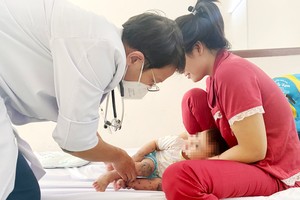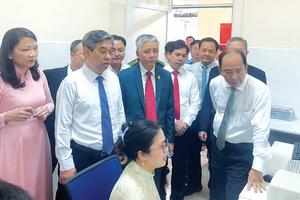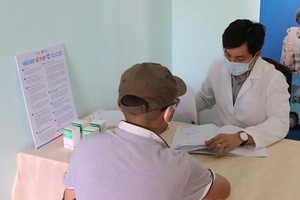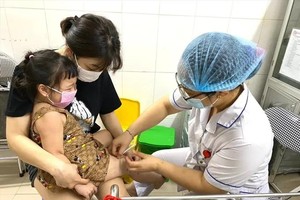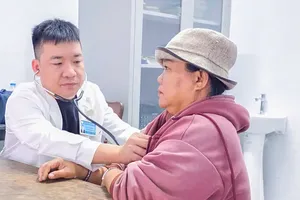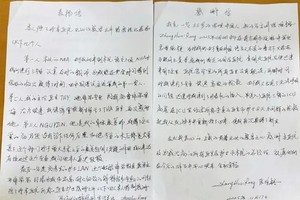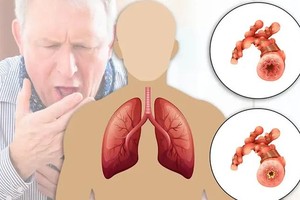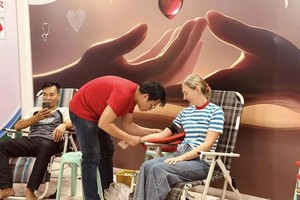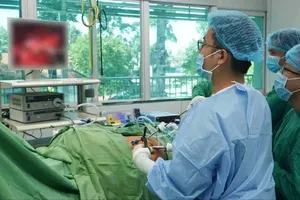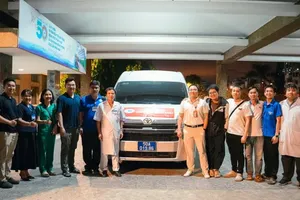In recent days, the number of new Covid-19 cases in HCMC has reached more than 2,000 cases per day, with the highest number at nearly 2,700. The increase in F0 cases has caused the number of F1 cases to rocket to tens of thousands of people, overloading field hospitals for Covid-19 treatment and concentrated isolation areas. The risk of cross-infection is thus also alarming. Experts said that it is time for self-isolation and home treatment for F0 and F1 cases to be done immediately.
Expanding home isolation for F1 cases
On July 14, the first household with five people in Long Thoi Commune in Nha Be District was isolated at home, a spacious four-story house.
Previously, the wife in this family was positive with SARS-CoV-2 virus and taken to a field hospital for treatment. The rest of the family became F1 cases.
After assessing the house, the health authority of Nha Be District determined that the four-bedroom house with four private restrooms was eligible for home quarantine, so F1 cases were allowed to self-isolate at home.
To ensure safety, medical staff instruct each person on how to receive food, classify household and hazardous waste for treatment, and avoid cross-infection if F1 cases turn to F0s. Twice a day, the community group of Long Thoi Commune provides supplies upon demand and supervises by making video calls to each person.
Not as fortunate as the above case, the family of Mrs. Nguyen Thi Thanh Thuy, 36, living in District 8, was sent to concentrated isolation after being informed that the combined test sample was positive.
At An Phong Primary School in District 8, her family of three people is arranged to share a room (using the classroom) with two other people. Every day, they are given three meals, and each of them has a mat to spread on the floor for sleep. The most inconvenient is the restrooms. Due to a large number of people under quarantine, the restrooms are always overloaded.
“The poor living conditions, lack of conveniences, and unpalatable food made us exhausted both physically and mentally. The most haunting thing is the buses that take people from the isolation area to the field hospital after having positive test results. Everyone feels panic and is afraid that when their turn will be," Thuy said.
Expanding home isolation for F1 cases
On July 14, the first household with five people in Long Thoi Commune in Nha Be District was isolated at home, a spacious four-story house.
Previously, the wife in this family was positive with SARS-CoV-2 virus and taken to a field hospital for treatment. The rest of the family became F1 cases.
After assessing the house, the health authority of Nha Be District determined that the four-bedroom house with four private restrooms was eligible for home quarantine, so F1 cases were allowed to self-isolate at home.
To ensure safety, medical staff instruct each person on how to receive food, classify household and hazardous waste for treatment, and avoid cross-infection if F1 cases turn to F0s. Twice a day, the community group of Long Thoi Commune provides supplies upon demand and supervises by making video calls to each person.
Not as fortunate as the above case, the family of Mrs. Nguyen Thi Thanh Thuy, 36, living in District 8, was sent to concentrated isolation after being informed that the combined test sample was positive.
At An Phong Primary School in District 8, her family of three people is arranged to share a room (using the classroom) with two other people. Every day, they are given three meals, and each of them has a mat to spread on the floor for sleep. The most inconvenient is the restrooms. Due to a large number of people under quarantine, the restrooms are always overloaded.
“The poor living conditions, lack of conveniences, and unpalatable food made us exhausted both physically and mentally. The most haunting thing is the buses that take people from the isolation area to the field hospital after having positive test results. Everyone feels panic and is afraid that when their turn will be," Thuy said.
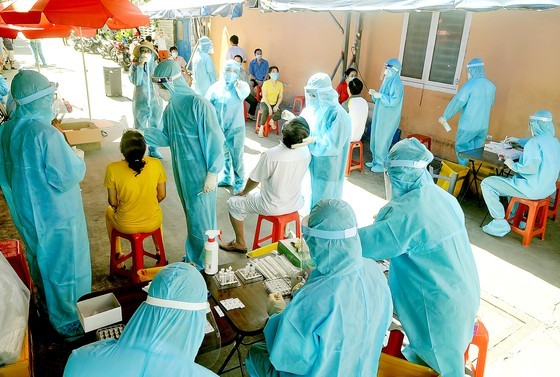 Health authority carries out Covid-19 testing in Ward 9 of District 10 on the morning of July 17. (Photo: SGGP)
Health authority carries out Covid-19 testing in Ward 9 of District 10 on the morning of July 17. (Photo: SGGP)
In June, the Ministry of Health had the policy to allow isolation at home for F1 cases. However, due to different ways of understanding self-isolation for F1 cases at home, at first, some districts in HCMC were confused in implementation. Recently, the Department of Health has issued specific instructions to the local health authorities on monitoring F1 cases at their residences. Currently, the city has 2,058 F1 cases isolated at home in various districts.Reducing treatment time for F0 cases at the hospital According to a report by the Department of Health of HCMC, the city had had 23,981 community transmission Covid-19 cases by July 17. On average, more than 2,000 new cases are detected every day. The city has put 24 Covid-19 treatment hospitals into operations, with a total capacity of 45,000 beds. However, currently many hospitals for Covid-19 treatment are becoming overwhelmed due to the rapidly increasing number of Covid-19 cases every day. To solve this problem, the Ministry of Health has issued an official dispatch on reducing the isolation time, piloting medical isolation at home for F1 cases, managing the treatment of Covid-19 patients. Accordingly, asymptomatic Covid-19 patients, who are being cared for and treated at medical facilities, can be discharged on the 10th day if two consecutive samples with a minimum of 24 hours apart have negative Covid-19 RT-PCR test results or low viral load with a CT value ≥ 30. They will continue to be monitored at home and residences for 14 days. For asymptomatic Covid-19 cases detected in the community with positive Covid-19 RT-PCR test results, if the viral load is low, they should be taken to a medical facility for isolation and monitoring. After 24 hours, if they continue to have a low viral load or the RT-PCR test results are negative for Covid-19, they should be discharged from the hospital and carry out medical supervision at home.Covid-19 cases without symptoms should be isolated at home Assoc. Prof.-Ph.D.-M.D. Le Minh Khoi, Head of the Science and Training Department of the University Medical Center Ho Chi Minh City, suggested that if Covid-19 cases are eligible to be controlled in the community, they should not be brought to hospitals. In fact, there are many F0 cases without symptoms, and many of them have awareness of Covid-19 prevention, behavioral capability, and sufficient housing and economic conditions to self-monitor at home. When the number of F0 cases is reduced, field hospitals will relieve a lot of pressure and are able to focus on treating patients with critical medical conditions to minimize mortality.
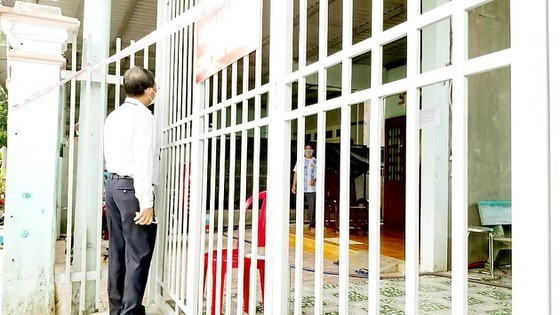 Medical staff checks on an F1 case isolated at home. (Photo: SGGP)
Medical staff checks on an F1 case isolated at home. (Photo: SGGP)
“Only cases of people with intellectual disabilities, old people with confusion, homeless people, people living in cramped accommodations, people whose family members living with chronic diseases that might worsen if they are infected with Covid-19, and people with high viral load should be sent to concentrated facilities for treatment," he emphasized. According to Assoc. Prof.-Ph.D.-M.D. Le Minh Khoi, in order for the monitoring and supervision of home isolation of asymptomatic Covid-19 cases to be convenient, it is necessary to train the leaders, deputy leaders, and community wardens of the residential group, and local police to closely monitor for distance compliance and oxygen saturation level. Medical staff will be assigned to each specific area depending on the density, number, and terrain complexity and only need to intervene when their conditions tend to go downward. Agreeing with this opinion, Dr. Truong Huu Khanh, an infectious disease specialist of Children's Hospital No.1, said that it is essential to allow asymptomatic F0 cases with low viral load to isolate at home amid the current situation. The important thing in home isolation of F0 cases is not to infect other family members. F0 cases should keep a distance of at least 2 meters from other people in the same house, do not eat and sleep together or stay in the same room. When providing supplies, they must keep a distance and wear masks and face shields. When F0 cases are alone in the room, they do not have to wear masks always. They must clean the surface of their desks, and the rooms must be well ventilated. The restrooms must be clean because this place is another source of pathogens. Drinking enough water, eating nourishing meals, getting enough sleep, living in moderation, and doing exercises is one of the measures to increase the body resistance to fight against the attack of the SARS-CoV-2 virus.



